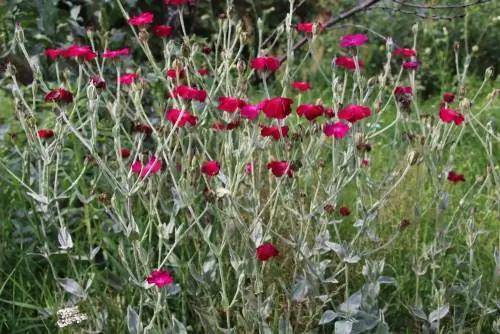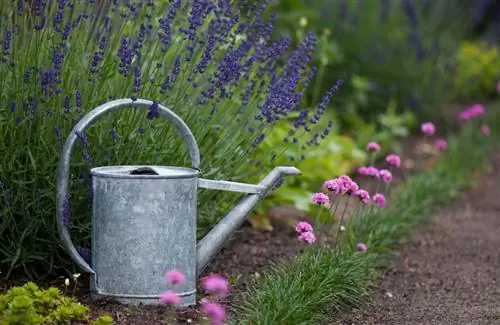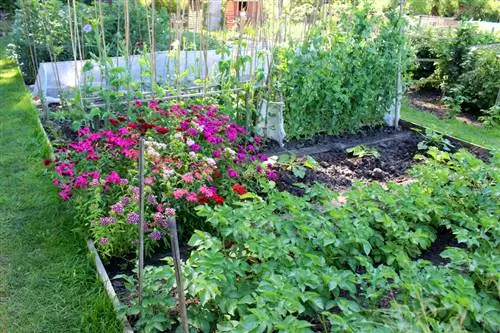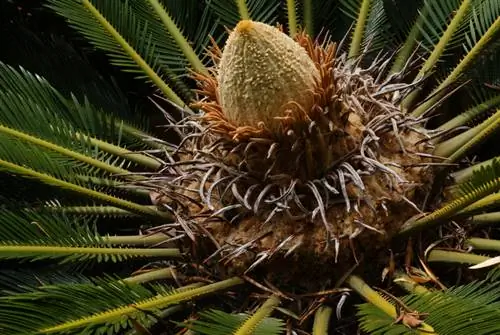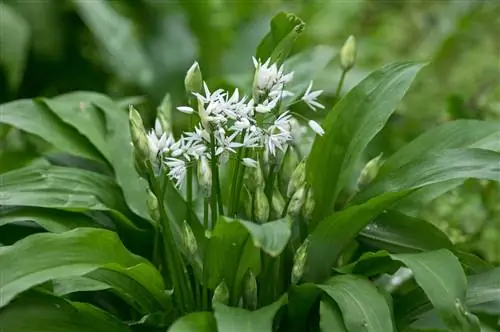- Author admin [email protected].
- Public 2023-12-16 16:46.
- Last modified 2025-06-01 06:02.
The crown carnation (bot. Silene coronaria, formerly Lychnis coronaria), also known as velvet carnation or Vexier carnation, is one of around 500 different types of carnations. Unlike most representatives of this genus, however, it does not have fringed flowers, but rather wheel-shaped, simple flowers of a bright purple-red color. These in turn provide an interesting contrast to the downy, gray-white shoots and leaves. The two to three year old puzzle carnations are ideal for dry and sunny locations and require little attention once they are in the right place.
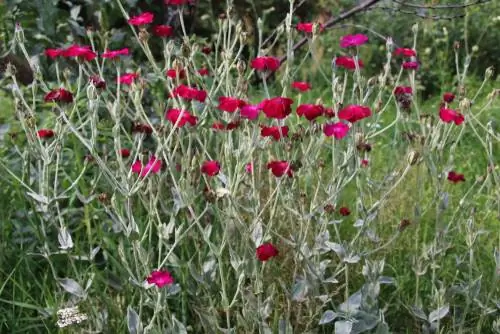
What is the carnation and how is it cared for?
The Vexier carnation (Silene coronaria) is a strikingly flowering perennial with bright purple-red flowers and gray-white, downy leaves. It prefers dry, sunny locations and is easy to care for and hardy. Ideal for beds and borders, it attracts butterflies and other insects.
Origin and distribution
“Vexiernelke” is one of the German common names for the crown carnation. He refers to the fact that the striking pink flowering plant does not have a scent: “Vexieren” means roughly the same as “deceive” or “tease”. Since 1995, the species has been assigned to the genus of campion (bot. Silene), which includes around 500 to 600 different species, which in turn belongs to the carnation family (bot. Caryophyllaceae). The species is originally widespread in southeastern Europe and Asia Minor - up to the foothills of the Himalayas - where it grows wild in open forests, bushes and rocky slopes. However, since Vexier carnations quickly become wild in suitable locations, they can also be found in the wild in numerous places in Germany. It has been in culture for a very long time - the first pictorial representation dates back to 1410.
Usage
Do not plant the attractive carnation individually in the bed, as the plant feels most comfortable in the company of its own kind - and also looks best in groups. The species is suitable for planting in open spaces as well as as a companion perennial in beds and borders, where it creates a harmoniously colorful overall picture together with yellow, white or blue-flowering species such as suneye, delphinium, garden sage, evening primrose or yarrow. As in its natural location, the Vexier carnation also feels very comfortable on the sunny edge of a woody planting - for example along a hedge. The pretty flowers attract numerous insects to the garden during their blooming period. Butterflies in particular fly to the pink flowers.
Appearance and growth
The evergreen Vexier carnation is a very short-lived, clump-forming perennial that can only be cultivated for two to a maximum of three years, but can be easily propagated by self-sowing in suitable locations. The herbaceous plant forms flat rosettes, while the flower-bearing stems reach heights of between 40 and 90 centimeters. All parts of the plant above ground have tomentose hairs.
leaves
The Silene coronaria, which has leaves all year round, develops its dense, white-grey hairy leaf rosettes in autumn and keeps them over the winter. In spring, felty-white flower stalks grow up to 90 centimeters high. These also have a few leaves that are narrow, lanceolate.
Flowers and flowering time
The pretty, approximately three centimeter wide flowers of the Vexier carnation appear between June and August. They stand individually on the loosely branched flower stalks and, depending on the variety, have a crimson to purple color. There are also some white flowering varieties. The broad, undivided petals are joined together at their base, giving the entire flower a plate-like appearance. Crown carnations bloom most beautifully in their second year.
Fruits
After flowering, numerous capsule fruits containing seeds are formed.
Toxicity
The clove is considered non-toxic, but is not suitable for consumption. Neither the leaves nor the flowers taste particularly pleasant.
Which location is suitable?
Place the Vexier carnation in a location that is as warm and sunny as possible. Although the perennial still thrives in light partial shade, it only produces a few flowers there.
Floor
Perfect is a place on nutrient-rich, fresh and sandy-humous soil that is loose and well-drained. Cloves wilt very quickly in very dry conditions, which is why the sunnier the perennial is, the moister the soil should be. The plant, on the other hand, cannot tolerate winter wetness - as can waterlogging or a wet subsoil. Therefore, plant the perennials on the edge of a garden pond or along a hedge; the vigorous plants can also often be found on a sunny slope or embankment.
Planting cloves correctly
Vexier carnation is usually sown in spring, but you can also plant purchased or pre-grown plants directly in the desired location. The ideal planting time is spring, but container goods can generally be placed in the garden until winter. The only requirement is that the weather is frost-free, mild and not too humid. When planting, maintain a planting distance of between 20 and 30 centimeters from other plants - you can plan around eight to ten plants per square meter of planting area. And this is how it is planted:
- Wet the root ball well before planting
- Dig out the planting hole - twice as wide and deep as the root ball
- Mix the excavated material with compost and, if necessary, sand/gravel
- Plant the clove as deep as in the pot
- Press the floor well
- water well and keep slightly moist in the following weeks
Watering and fertilizing
Vexier carnations planted in the garden do not need to be fertilized, but they do need an additional water supply during longer periods of drought.
Cutting cloves correctly
Pruning is also only necessary for this very easy-care perennial if self-sowing is to be avoided. In this case, cut the plants to about 15 centimeters above the ground after the flowering period, then they can no longer produce the seed-containing capsule fruits. You can also remove wilted leaves from time to time.
Propagate clove
The perennials die after about two to three years, but reproduce very reliably through self-sowing or through the numerous runners. Within a short time, dense carpets of plants form, the spread of which has to be limited rather than promoted. However, propagation by division is not necessary.
Specific propagation is best achieved by sowing, whereby you can either purchase the seeds commercially or collect them yourself - the capsules are ripe as soon as they burst open and release the seeds. This is how you sow:
- sown in spring
- Sowing directly on site or in a container
- sunny to light, partially shaded location
- Use loose and humus-rich potting soil
- prepare them well, loosen them up and remove weeds
- Spread seeds, but do not cover them with soil - light germinator
- just press lightly
- Slightly moisten the soil and keep it slightly moist at all times
- Avoid waterlogging
- Prick out plants as soon as they have at least four leaves
By the way, Vexier carnations can be socialized very well with other carnation species, which not only creates an exciting picture in the flowerbed - the closely related varieties cross with each other, so that with a bit of luck new varieties will emerge.
Wintering
Vexier carnations are hardy and do not require any additional winter protection. The only thing that should be avoided is winter wetness, as the plants cannot tolerate it. To protect them from constant rain and snow, you can cover them with fir or spruce branches.
Diseases and pests
The Vexier carnation is not only extremely easy to care for, but also very resistant to diseases and pests. The only problem that usually becomes problematic is fungal infestation due to excessive moisture or even waterlogging in the bed. In this case, the infected plants should be removed immediately to prevent further spread. Aphids are the most common pests, but they can be removed quite easily. Snails, on the other hand, avoid the plants, so there is no danger from this direction.
Vexier carnations are not blooming, what should I do?
The flowering crown carnations often only show their colorful flowers in their second year. However, if the flowers do not want to bloom at all, either the location is not suitable (too dark and/or too moist) or pests are robbing the plants of the strength to develop their flowers. So either move the cloves or put an end to the pest infestation using suitable means.
Tip
Vexier carnations make - especially in combination with other summer flowers - pretty and long-lasting cut flowers for the vase.
Species and varieties
Numerous different cultivars of the crown carnation are commercially available. These varieties are particularly attractive in the flowerbed:
- 'Abbotswood Rose': pretty, pink flowers
- 'Alba': pure white flowers that go wonderfully with other white-flowering perennials
- ‘Angel’s Blush’: also flowers white, but with a pink eye
- 'Atrosanguinea': variety group with strong magenta to crimson flowers
- 'Blushing Bride': white flowers with a pretty pink eye
- ‘Dancing Ladies’: Mixture of white, pink and cherry-red flowering varieties
- ‘Hutchinson’s Cream’: white flowers and pretty spotted foliage
If you want to create variety in the flowerbed, plant other types of carnations in addition to the Vexier carnations, such as these:
- Alpine campion (Silene suecica or Lychnis alpina): purple-red, dense flower clusters between May and June, bushy, sprawling growth, maximum height of up to 15 centimeters
- Common pitch carnation (Silene viscaria): pretty pink to red flowers between May and June, height up to approx. 40 centimeters, strongly branched growth, for dry locations, varieties include 'Fire' or 'Plena' (variety with double flowers)
- Cuckoo Campion (Silene flos-cuculi): native species with fringed, pink flowers between May and June, strongly branched, bushy growth with heights of up to 40 centimeters
- Lychnis x arkwrightii 'Vesuvius': Hybrid of the scarlet carnation and the garden carnation, produces strong orange-red flower umbels between June and July, has dark foliage, height up to approx. 40 centimeters
- Red carnation (Silene dioica): native species with strongly branched inflorescences and bright red flowers, blooms for a very long time between April and October - the individual flowers only open for one day each, bushy growth with heights of up to 90 centimeters, for moist and lime-rich soils
- Scarlet carnation or burning love (Lychnis chalcedonica): forms spherical, bright red umbels between June and July, bushy growth with heights of up to 80 centimeters, for full sun locations
- White carnation (Silene latifolia): native species with numerous white flowers, which only open in the afternoon and have a strong scent, blooms between June and September mainly on nitrogen-rich clay soils, bushy growth with heights of up to 120 centimeters

